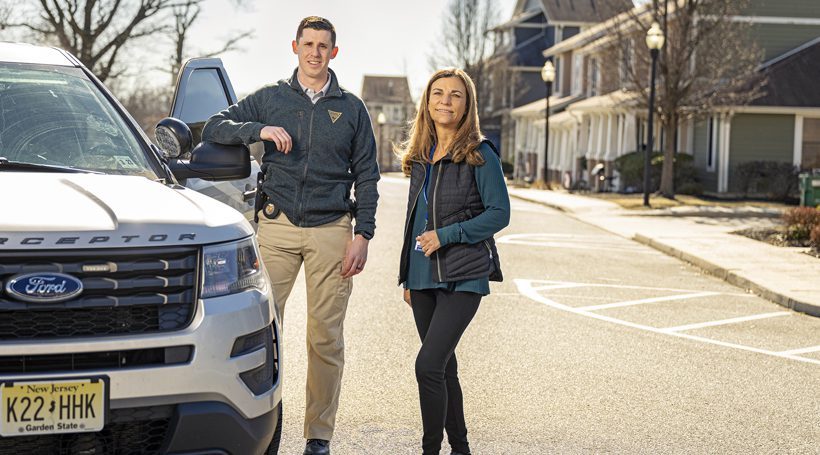NJ State Trooper Ryan Dolan and Elvira Smith
Photograph by David Michael Howarth
Over the 4 decades Elvira Smith has worked as a mental-health crisis responder in South Jersey, there have been maybe a handful of times when situations have gotten heated enough that she’s called for police backup.
On the flip side, New Jersey State Trooper Ryan Dolan has responded to countless 911 calls involving people in mental distress.
Until late last year, the chances that the 2 would go together to an emergency call involving a mental health crisis were slim to none. That changed, though, when Cumberland County was chosen to launch a program designed to strengthen relationships between police and mental health providers. Called ARRIVE Together, an acronym for Alternative Responses to Reduce Instances of Violence & Escalation, it pairs State Troopers with mental health screeners to respond to some emergency calls.
Over a 10-month period, ARRIVE Together teams have responded to 55 emergency calls in Cumberland County, resulting in 79 follow-up visits and no violent encounters. Considering that 2 out of every 3 uses of force by law enforcement in New Jersey have typically involved a person identified as either suffering from mental illness or under the influence of drugs and alcohol, that last data point is encouraging, says Acting New Jersey Attorney General Matthew Platkin. Recently, Platkin announced that ARRIVE Together will expand to 2 cities in North Jersey, Linden and Elizabeth.
The move is part of a broader trend nationally to rethink how first responders handle mental health crises. And it coincides with the debut of 988, a new national hotline for mental health issues, substance abuse and suicide prevention.
As the program ramps up in North Jersey, it continues its run in South Jersey. Dolan and Smith are among several teams paired together on 8-hour shifts twice a week out of the State Police barracks in Bridgeton and Port Norris. During the shifts, the teams respond to crisis calls and also make follow-up visits to people they encountered on past calls to make sure they’re getting the treatment they needed. They don’t just arrive at the call together – the health screener works at police barracks for the entirety of the shift.
Ryan, who does not wear a uniform or carry a gun on these shifts, says having a health screener on the call has some clear benefits because they can start treating people in distress immediately. In the past, he says, especially late at night, his ability to help people during a crisis would be limited to encouraging them to go to a hospital emergency room – where they would likely wait for hours to be seen.
Through observing Smith and the other health screeners in action, he adds, he has adopted some of their techniques for communicating with people in mental distress.
Smith says she’s picked up some helpful tips from the officers as well.
“I’ve seen several of the officers tell someone to ‘look at me’ when they’re talking, and it’s very effective,” says Smith. “Individuals in crisis situations tend to drift away – they’re thinking about what’s happening versus listening to what you’re saying to them. When you’re able to get the individual to look at you, you can see them actually start to calm down and you can have a better conversation.”
“There’s a lot more exchange of information. And that’s what we want.”
She recalls one situation involving a person in distress, where she and the officer arrived to a chaotic scene of a family conflict. Tempers were flared, and there was a lot of noise. As the officer worked at calming family members, she took the person in crisis away to a quieter part of the house.
“When I’m on the scene and the person is in crisis,” Smith says, “I can better understand the home environment and make a better assessment of other factors that may be contributing to their distress.”
Another advantage of working with police is that, during downtime in the barracks, the officers can recount calls they’ve had and discuss different ways they could have responded. In turn, she has a better understanding of their experiences.
“There’s a lot more exchange of information,” she says. “And that’s what we want.”
The program was formed in response to data about the use of force by law enforcement officers in New Jersey. It’s an acknowledgment, says Platkin, that there’s room for improvement.
“The fact that we’ve had zero uses of force since ARRIVE Together piloted in Cumberland County underscores the importance of this program,” adds Platkin, “And the impact it could have.”














